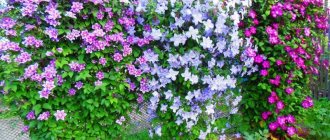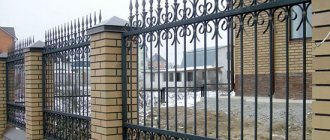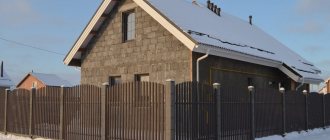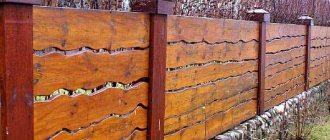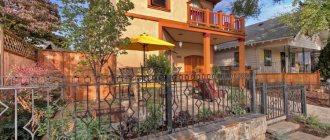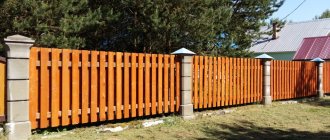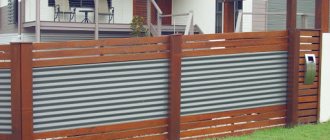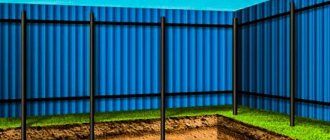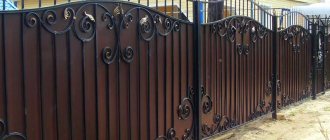- Concrete sectional fence: product characteristics
- Types of prefabricated concrete fences
- Decorative, block and stacked concrete fences
- Pros and cons of concrete sectional fences
- Characteristics of concrete fence posts
- Caps for concrete fence posts
- Installation of a concrete sectional prefabricated fence
- Installation of inlaid fencing
- Options for decorative finishing of a fence made of concrete panels
- How to make concrete fence sections
- Video: technology for manufacturing concrete prefabricated fences
Owners of private households, in order to protect their homes from the entry of unauthorized persons and from curious glances, frame the territory with a continuous, strong and reliable fence. The best option is a sectional concrete fence, which has a number of distinctive advantages, attractive appearance and affordable cost.
Concrete fences consist of panels of the same size.
Concrete sectional fence: product characteristics
The concrete sectional fence is a modular structure, the individual elements of which are manufactured using vibratory casting technology. The working solution is prepared from cement with a strength grade of at least M500, clean river sand, fine gravel or granite filler up to 5 mm in size, water, color pigments and modifiers. The resulting mixture is filled with special forms, which are placed on a vibrating table, where a reinforcing mesh made of steel no lower than VR-1 is also placed. The solution is evenly distributed and compacted, which allows you to achieve a smooth surface of the products. The concrete should harden within 2 days.
Concrete fence is highly durable.
Concrete slabs for fences can be made in the form of solid or lattice products or wickerwork with voids. Sections are one- or two-sided. Depending on the forms used, more than 300 varieties of products can be obtained. The use of vibration casting technology allows us to obtain durable products with a flat, smooth surface that does not allow moisture to pass through, providing increased frost resistance. The minimum service life of concrete sections is 25 years.
Concrete modular slabs are produced in a standard size of 50x200 cm. When individually ordered, products may have other dimensions. The weight of one element is 40-75 kg depending on the thickness, which can be 4-6 cm, which affects the price of a concrete sectional fence. The cost of one slab can vary between 300-700 rubles. When installing a fence, the number of sections is selected based on the height of the fence. If the fence is installed to divide the area or as decoration, one or two sections are sufficient. A fence that performs a protective function must have at least 3 sections.
Types of prefabricated concrete fences
Fences made from concrete sections come in different designs and for various purposes. They are presented in five variations:
- Monolithic.
- Monolithic self-contained.
- Block.
- Typesetting.
- Eurofences.

Each type of concrete fence is divided into separate subtypes, where the products differ in the production method, installation location and design, which also affects the cost of the concrete fence. A monolithic concrete fence is the most durable option. However, such fencing is heavy, which complicates its installation. When installing monolithic sections, it is necessary to prepare a strip or columnar foundation, which other fencing options may well do without.
Note! To install a monolithic fence, you will need to use construction equipment.
Monolithic fences consist of reinforced concrete slabs 5 m long, 2.2 m high and 12 cm thick. The weight of one element reaches 3 tons. During the manufacturing process, the slabs are reinforced with plastic or metal fiber to improve the soundproofing characteristics of the product.
A monolithic self-standing fence is mounted without a foundation, which is achieved due to the presence of a wide base. It can be installed on a horizontal wide base or inserted vertically with spikes into glasses. Thanks to this feature, fences can be installed in places with high groundwater levels. Such fences are not decorative. They can have a smooth or ribbed surface. They are mainly installed in industrial areas.
Flaws
Many owners give preference to such a fence. However, they must take into account the disadvantages of this type of design:
- Through a high concrete fence, light and air cannot pass in sufficient quantities. Against this background, plants grow slowly. This is why it is difficult to create a beautiful flower bed. To minimize the negative impact, it is recommended to choose slabs with small holes.
- High cost of fencing. You can verify this if you study the price list in detail. In it, as a rule, prices for wood, corrugated board and metal are much lower.

The high cost is compensated by aesthetic and strength characteristics
When choosing European sections made of concrete, it is possible to create an excellent fence for any site. They will not only protect the house from prying eyes, but will also protect it well from negative external influences. The slabs are often decorated with artistically designed leaves.
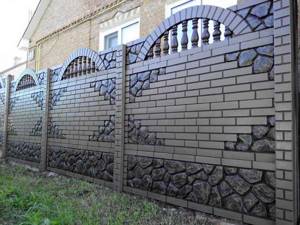
The disadvantage of such fences is their fragility under point loads.
The style directly depends on the chosen color scheme, size and height. That is why it is recommended to analyze these criteria in detail before placing an order. Today it is also possible to create fence blocks according to individual sketches.
Standard options are distinguished by the thoughtfulness of each element. Manufacturers have a range of finished panels ranging from 200 pieces. Decorative concrete blocks for the construction of fence posts differ in shape, shade and pattern.

Industrial production of sections reduces edge inaccuracies
A concrete sectional fence goes well with elements made from other materials. Thanks to this, it is possible to obtain an unusual design. They can be decorated with forged, wooden or other elements.
Before installing a decorative concrete fence, it is necessary to carefully analyze the types and design features. They are presented in several versions:
- Small stacked sections are suitable for highlighting individual zones near the fence. It can be made of completely decorative material. Such a fence does not protect from prying eyes, but is an excellent addition to any site. If there is a need to use a fence to keep a pet inside the yard, then it will need to be made of at least two sections.
- The decorative form can be installed on top of two reinforced concrete blocks. It is additionally decorated with decorative elements, three-dimensional figures and patterns.
- The fence of four sections is tall and heavy. Before installing it, you will need to make a foundation that will support the significant weight of this structure.

Installation of the main horizontal guide of a concrete fence
Decorative, block and stacked concrete fences
Block concrete fences are made from monolithic or hollow blocks. When installing such a fence, there is no need to use intersectional concrete fence posts. Concrete blocks are laid out according to the principle of brickwork. The elements are connected to each other using cement mortar. The disadvantage of such fences is the need for decorative finishing of products using textured plaster or tiles.
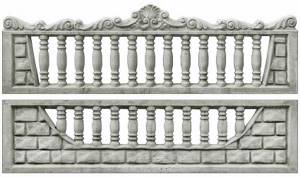
Stacked fences have a variety of decorative options.
Prefabricated concrete fences are distinguished by high decorative qualities. Each set consists of 2-4 elements measuring 50x200 cm, which are made in different variations of texture and color. They can be uniform, imitate stone, wood or brick, and contain images and patterns. The slabs can be blank or through with ornaments. Sections are produced with a matte or glossy surface.
Euro fences are highly decorative and have good technical characteristics. Products are presented in a wide variety of textures, shapes and colors. You can choose options that imitate the look of natural stone, brickwork, wood or balustrade. The price of a decorative concrete fence starts from 500 rubles. for one slab.
On a note! Eurofence can be purchased in a combined design using forging and decorative stone.
Eurofences can be one-sided or two-sided. The first option includes designs in which the texture or pattern is applied only to the front part. Double-sided options have decorative trim on both sides.
Main types

However, the main criterion for fencing is the level of strength and reliability of the finished structure.
These characteristics are fully consistent with monolithic models in the form of solid cast slabs, which must be installed on a solid and strong foundation of a strip or column type.
The significant weight of the elements will require the use of special equipment.
The most popular models imitate:
- wooden board;
- grapevine;
- stone chip;
- convex or concave brickwork;
- ancient mosaic;
- oriental ornament.
Stacked concrete models are distinguished by a variety of slabs inside the section, which allows you to experiment with the appearance of the installed fence. Most often, the upper part of the element is completed with a beautiful decorative design. In height, the stacking sections usually consist of three or four slabs mounted in special grooves on the posts. The main advantages of this option are the variety of types, ease of installation with your own hands and exclusivity of the external design.
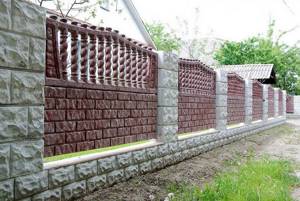
Installation of decorative concrete fences
Self-standing decorative concrete fences have significant weight, but due to the width of the horizontal base, they do not require a foundation.
This option belongs to the budget category, but does not have a very original and attractive appearance, so it is most often used as a fence on construction sites or industrial areas. Recently, double-sided concrete fences have become especially popular, characterized by external aesthetics not only from the outside, but also from the inside of the fence.
Combining some models of slabs with inserts based on wood, stone, metal and mesh allows you to get an individual fence with an original, highly decorative appearance.
Pros and cons of concrete sectional fences
Fences made of concrete slabs are very popular among owners of private territories, due to the fact that they have many advantages. Concrete enclosing structures are strong, reliable and durable. The products are equipped with a metal base, which is securely hidden in layers of concrete. Such a fence can withstand significant mechanical loads.
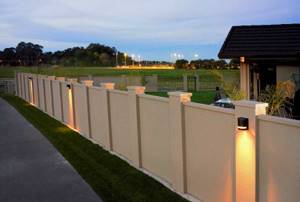
Euro fences are suitable for many architectural styles of the house and local area.
Concrete structures are characterized by increased moisture and frost resistance, resistance to strong gusts of wind, and fire resistance. They are not subject to corrosion and rotting. Sectional concrete fences are easy to install. They can be installed on any soil. Thanks to the mobility of the products, the fence can be disassembled and moved to another location. The sectional structure of such a fence eliminates the formation of gaps. Such fences do not require special care or additional costs associated with their operation.
Thanks to the variety of product designs, a fence created from prefabricated elements can become a real masterpiece, which will stand out with its individual and unique appearance, as confirmed by photos of concrete fences. Sections are available in various textured designs. There are options with imitation wood, stone, forging, stucco, and tile. You can choose different color variations, creating interesting aesthetic compositions.
On a note! A concrete sectional fence fits any design style of the local area, ideally combined with different finishing materials.
Among the disadvantages of concrete fences, one can highlight the large weight of the products, which requires the use of special equipment for the installation of slabs or several persons with sufficient physical strength. Also, monolithic barriers are characterized by airtightness. They will block the light for nearby plants.
Characteristics of concrete fence posts
Important structural elements of a concrete fence are support pillars, which ensure strength, reliability, resistance to mechanical stress and durability of the structure.

Concrete sectional fence with rectangular posts.
They produce solid and stacked concrete fence posts. The first type is characterized by high strength and the ability to withstand significant loads. Prefabricated poles are represented by hollow decorative elements that are strung on a metal base. They are connected to each other using concrete, which is poured into the internal cavity. Such products are highly aesthetic. Individual elements may have patterned or raised decorations. The price of concrete fence posts starts from 600 rubles. per unit of product, and the cost of monolithic supports starts from 700 rubles.
Support structures can be round, square, triangular or polygonal. Based on the method of attaching sections to them, poles are produced with longitudinal grooves, metal loops and embedded wood bars. The fixation option depends on the type of fence. When installing monolithic fences, supports with grooved connections are mainly used.
For the fence, you can choose monolithic posts that lack aesthetic appeal, or products stylized as marble, stone, wood and other materials. You can make concrete fence posts with your own hands. To do this, you should prepare a frame of wooden boards, into which concrete mortar with mandatory reinforcement is poured.
On a note! To make round concrete pillars, you will need a pipe of a suitable diameter.
Manufacturing of concrete sections
Currently, there are several technologies for the production of reinforced concrete sectional elements for a concrete fence. However, the most popular and relevant is the fast release technique, which allows you to achieve maximum productivity. During the manufacturing process, special molds are used, which are lubricated and placed on a vibrating table before pouring. As the cavities are filled by 50% with concrete mortar, the section is subject to reinforcement using a flat frame made of steel wire. After this, the solution is poured until full with the vibrating table turned on. Upon completion of the filling procedure, excess mortar is removed, and the slab can be leveled in individual places manually using a spatula. When the reverse side acquires a smooth surface, the section is removed from the mold and sent to dry.
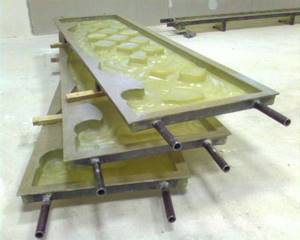
Caps for concrete fence posts
Caps, which are also called covers, tips, caps or protective lights, are often installed on concrete fence posts. They are manufactured on special equipment using vibration casting technology. Frost-resistant additives are added to the working cement mixture, which increase the moisture resistance of the products, and fiber fiber, which increases the strength characteristics of the caps.
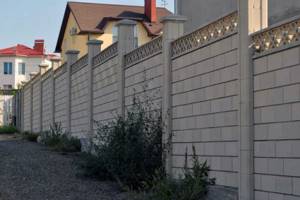
The caps protect the fence from moisture penetration.
To obtain a specific color for fence post covers, special dyes are used, thanks to which the products retain their original appearance and rich color without fading in the sun. Concrete caps on pillars protect supporting structures from the penetration of moisture, which gradually washes out the binder, erodes the seams, promotes the formation of deep cracks, thereby reducing the service life of the structure, and it gradually collapses.
In winter, at subzero temperatures, water crystallizes, increasing in volume, which contributes to the disruption of the integrity of the support column. The protective effect is achieved due to the inclined position of the outer surface of the cap, which ensures free flow of water. Covers for concrete fence posts serve a decorative function, providing a presentable appearance for the fence. The products are presented in a variety of shapes and colors.
Note! Caps for concrete poles are susceptible to impact loads, which requires compliance with certain measures during their transportation.
Depending on the design, concrete parapets on the fence can be:
- pyramidal, with a large number of faces;
- spherical, which are distinguished by the large radius of the spherical part and large dimensions;
- conical, which have a ribbed or smooth surface;
- made to look like tiles.
The outer contour of the protective lights can be made in the form of a circle, rectangle or square. Products can be pitched, flat, ribbed, stepped, with peaks, decorated with balls.
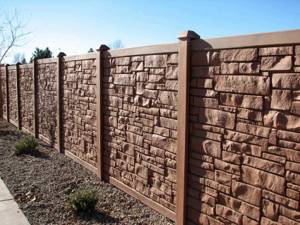
The texture of the fence imitates natural stone.
Installation of a concrete sectional prefabricated fence
Before installing a concrete fence with your own hands, you must correctly determine the number of concrete sections. The length of the products is 2.06 m. When calculating the number of sections, you should also take into account the cross-section of the support pillars and the presence of technological gaps.
The first step is to determine the perimeter of the fence. From the obtained value, subtract the width of the gate, wicket and gate supports. Next, you need to calculate the number of supporting structures. Here it should be taken into account that two pillars are dug in at the corners. The value obtained after subtraction must be divided by the length of each section. This determines the total number of fencing slabs.
When purchasing parts for a concrete fence, it is necessary to perform a test measurement of its elements, measuring the thickness of the slabs and the parameters of the mounting grooves. Before marking the perimeter, you should perform a test assembly of the structure. The slabs are laid flat on a flat, dry area, so that they do not touch the ground. For this, bars or boards are used. On both sides of the sections, pillars are placed upside down so that the ends of the concrete panels fit completely into the mounting grooves. The distance between the axes of the support pillars is measured, which will be the installation size of the concrete fence.
Before installing a monolithic concrete sectional fence, it is necessary to prepare the base, represented by a shallowly buried tape. To do this, the territory is marked around the perimeter of the site to determine the size of the sectional concrete fence. Next, a trench is dug according to the markings. A sand cushion is formed at the bottom. Formwork is installed in the trench. Next, concrete fence posts are installed. Using a building level, the verticality of the elements is checked. It should be taken into account that there should be a distance of 2 m between the supports. The trench is filled with concrete.
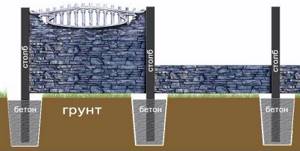
Installation diagram of a concrete sectional fence.
Modular concrete slabs are inserted between the supporting elements into the corresponding grooves. When installing a gate or wicket, it is necessary to mount separate pillars to which metal inserts for the gates will be welded.
Stacked fence
This type of fence is suitable both for use in the private sector and for fencing the territory of parks, kindergartens, and office areas. A prefabricated fence is assembled from concrete sections installed vertically on top of each other in each span.

The number of sections in one span can be from 3 to 5; they can be made in the same style or differ from each other in texture and ornament. The vibratory casting technology used for the manufacture of sections ensures high quality of mold filling, a high degree of compaction and strength of concrete.
This makes it possible to produce surfaces with a wide variety of textures - with ornaments or imitation of brick, marble, natural stone. For the upper sections, you can use non-solid slabs with balusters and openwork elements.
To install the sections, reinforced concrete support pillars with grooves are used, manufactured using the same technology and corresponding to them in design. The pillars are installed in the ground to a depth of 1.5 m at a distance of 2 m from each other. When installed in a pit, they are first secured using steel reinforcement, the necessary adjustments are made to the sections, and only then they are finally filled with concrete.
Installation of inlaid fencing
When installing a concrete fence, there is no need to build a foundation. The territory is marked using a cord. Next, you should prepare wells for support pillars, which can be solid or prefabricated. The distance between them should be 2 m. The depth of each well is 0.7-0.8 m, size 50x50 cm. A cushion of crushed stone and sand, at least 20 cm high, is placed at the bottom of the hole, which should be compacted with water.
Installation of supports begins from the corner. Each support is buried no more than 0.5 m with mandatory fixation with supports. The free space around the support is filled with crushed stone. The element is strengthened using cement mortar in a 3:1 ratio of sand and cement, which is performed after the final installation of the fence. Between the supports, plates are inserted into the existing grooves. After installing each element, it is necessary to check how level the fence is. You should immediately place the first level of concrete blocks for the fence posts. After some time, you can move on to the second, which will eliminate the possibility of it being beveled.
The final stage of installing a concrete fence is installing concrete covers on the fence. It is first necessary to clean the end surface of the column and apply primer to it. Next, it is covered with a layer of adhesive mixture intended for use in outdoor conditions. A decorative cover is installed on the pole, which must be positioned strictly horizontally. Before the adhesive composition hardens, the protective lamp must be kept stationary.
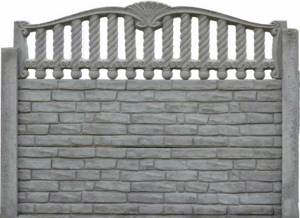
You can install a concrete fence on your own.
Note! When installing the cap, ensure that the product hangs over the support along the entire perimeter.
After the protective cover is completely fixed, you can attach decorative elements to its surface.
Options for decorative finishing of a fence made of concrete panels
There are several options for decorative design of a concrete sectional fence. To do this, you can use tiles, polycarbonate or wooden inserts, forging elements, plaster or paint. Slabs of a concrete sectional fence (photos clearly confirm this) can be designed to match the texture of wood, crushed natural stone, imitate brick or log masonry, lattice or baluster. The spatial openwork structure, weaving from bamboo and wicker looks original and unusual.
A boring monolithic concrete fence can be painted in any color that can be combined with other landscape and architectural elements of the area. To do this, it is necessary to use special paint and varnish compositions, which consist of pigment and polymer components. Such dyes are characterized by environmental friendliness, wear resistance, excellent moisture-repellent properties, and resistance to negative environmental influences.
To paint a concrete fence, you can use acrylic compounds for concrete, water-dispersion, latex, rubber paints, and special silicone dyes. In order for the fence to harmonize with other elements of the landscape, it is important to choose the right shade of paint for the concrete fence. Do not give preference to too bright contrasting colors. The shade of the fence should match the tone of the roof. If the buildings on the territory are painted in a warm palette, you should not choose blue or gray for the fence.
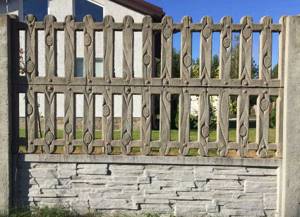
Interesting decorative design of the fence.
Note! To paint a fence, it is enough to use no more than three colors.
The surface should be prepared before painting. It is cleaned of dirt and primed. Next, a special impregnation is applied to the concrete. The surface is painted with paint using a brush or roller, moving from top to bottom.
On a note! The fence must be painted completely in one day so that there are no differences in tone.
After the first layer has completely dried, it is necessary to apply a second one.
Advantages
Concrete fences have a number of distinctive properties and can be different depending on the material chosen during construction:
- The fence is highly durable, especially if equipped with metal reinforcement;
- Service life exceeds 50 years;
- Resistance to environmental influences;
- Does not ignite in case of fire;
- Protected from fungal infections;
- Does not require a strip foundation for installation.
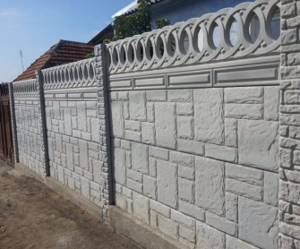
It is also important that installation of a concrete fence is possible on any type of soil cover. But in some cases, due to the special structure of the soil, you will have to resort to special methods for installing pillars.
How to make concrete fence sections
To make sections of concrete fencing you will need a vibrating table and several molds. To mix the finished solution you will need a concrete mixer. To obtain high-quality products with high strength and performance characteristics, it is important to correctly prepare the working solution. It will require concrete grade M400 or M500. Screened river sand without clay inclusions is used as filler. It must be sifted twice before use.
The working solution is prepared in the proportion of cement, sand and crushed stone 1:1.1:2.5 using Portland cement M450. If M400 grade material is used, then the ratio of the components should be 1:1.2:2.7. The solution is mixed in an electric concrete mixer. Water should be added gradually until the solution reaches a consistency resembling thick sour cream. In order to make colored sections that will not require additional coloring, you need to add a special pigment to the batch, in the amount specified by the manufacturer.
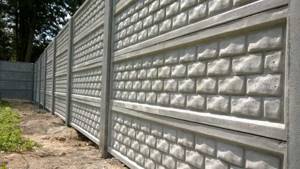
DIY concrete fence.
After mixing, the finished concrete mixture is poured into fiberglass molds for concrete fences, which are placed on a vibrating table to compact the solution. Two technologies can be used to produce slabs: exposure and instant formwork. In the first case, the solution must remain in the molds until it gains strength, and in the second, the formwork is removed after the concrete compaction process is completed.
Sections made using the exposure method are characterized by greater strength, absence of defects and high decorative qualities. Products made using instant formwork technology may have minor defects. Such sections are not aesthetically pleasing. They are mainly used in the installation of fencing for industrial areas, car parks and warehouses. At the pouring stage, the sections are reinforced, which will make it possible to obtain strong and reliable products that exhibit increased resistance to mechanical and impact loads. For this, metal rods with a smooth or corrugated surface are used.
Concrete sectional fencing is very popular due to its high technical and operational characteristics, ease of installation, variety of textures, designs and colors of its constituent elements. An undeniable advantage is the affordable price of concrete pillars and slabs, as well as the durability of the structure.
Technology for the production of concrete fences
Catalog: Forms, equipment, additives
Concrete fencing is intended for arranging the fencing of residential buildings, enterprises, social and cultural facilities. The shape, height, presence or absence of a design solution is determined by the type of development, location, operation, technical and economic indicators, etc. Fences in private areas are the first stage of arrangement for your comfort and a source of pride for the owner.
For the manufacture of fences, the injection molding method is used; it is most effective in the production of products of small thickness (including roofing tiles, paving and facing tiles, permanent formwork, MAFs, etc.).
For the manufacture of concrete fences the following are used:
- Portland cement M500D0 (without additives);
- sand with a particle size modulus of more than Mkr 2.0 (ideal - fraction 2.5), the content of clay particles in the sand is no more than 3%;
- crushed granite stone of grade more than 800, fraction 5-10 mm is allowed;
- plasticizing additives;
- water;
- reinforcement: for the frame - steel Vr-1, diameter from 4mm, for pillars: 0.5m - V-1 4mm, 1m - Vr-1 4mm, 1.5m - 6mm, 2.0m - 8mm, 2.5m - A3 10mm.
This solution recipe is also used for the production of concrete panels for fences.
The concrete mixture should be prepared in a special mixer, then it will have high mobility, non-segregation, excellent casting qualities, and as a result, the products themselves will be durable, frost-resistant and have a long service life.
